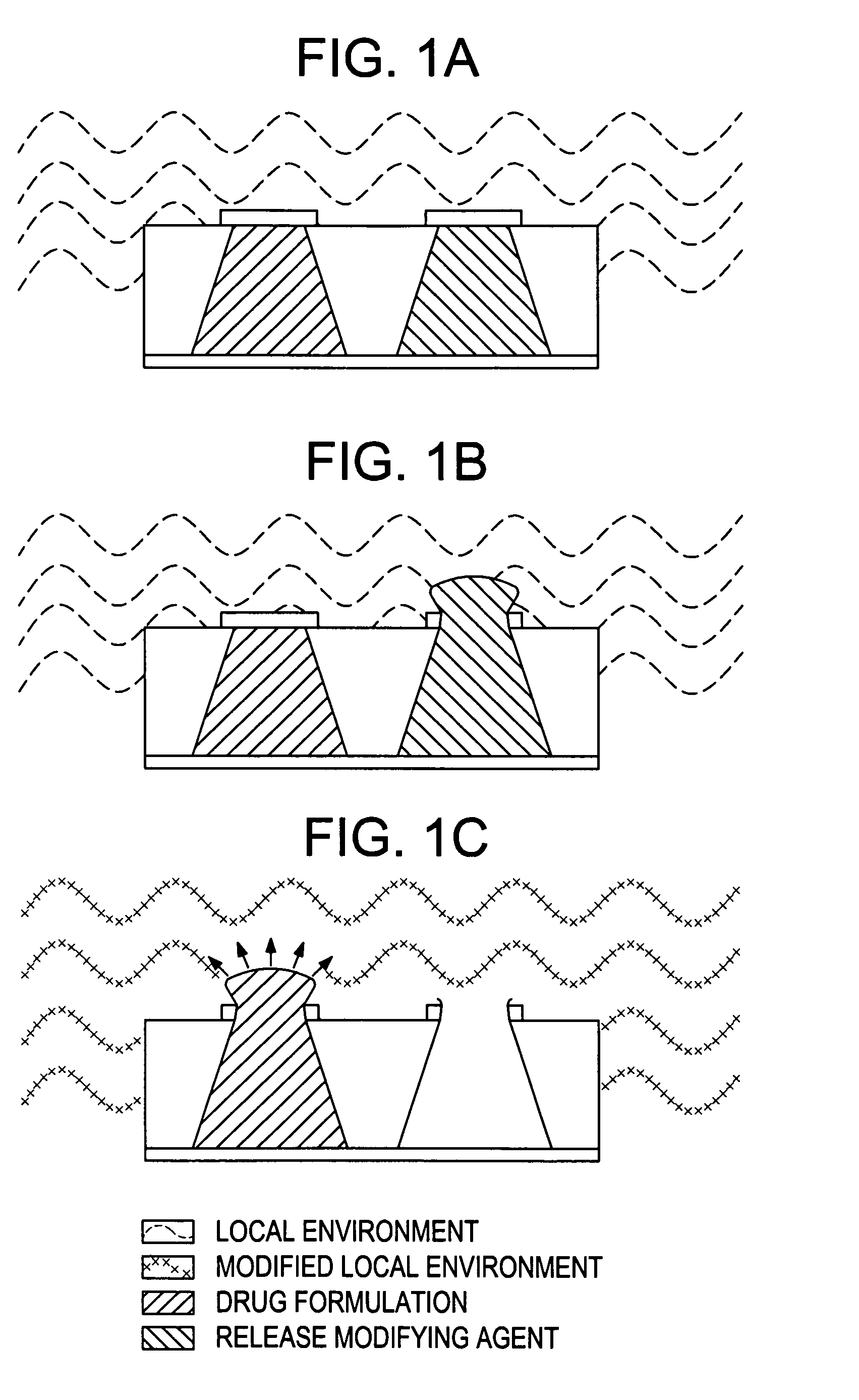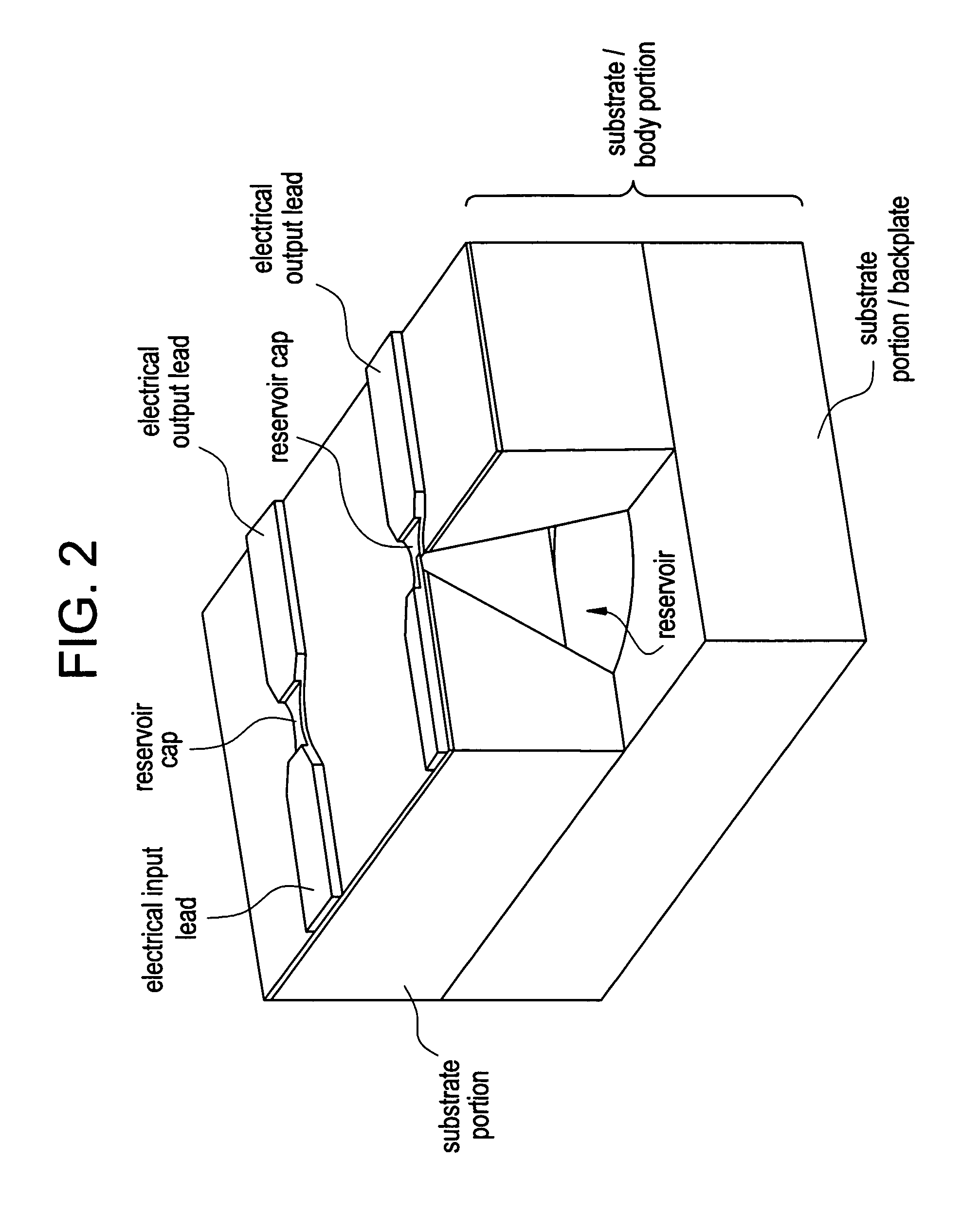Control of drug release by transient modification of local microenvironments
- Summary
- Abstract
- Description
- Claims
- Application Information
AI Technical Summary
Benefits of technology
Problems solved by technology
Method used
Image
Examples
example 1
Enhanced Release of Teriparatide from Reservoir Using with Tartaric Acid / PEG Backfill
[0101] A teriparatide solution was prepared adding 200 mg of teriparatide per milliliter of solution to a 25% acetic acid in water mixture. (The acid concentration is approximate, as it assumes no volumetric contribution of the teriparatide to the solution.) Device / substrate reservoirs were filled using 100-125 nL of the teriparatide solution. The teriparatide was then lyophilized to yield a solid dosage. For concentrated lyophilized dosages, the reservoir was filled with a concentrated drug solution. Then the solution was frozen and lyophilized to form a reservoir-bound porous drug cake.
[0102] The porous teriparatide dosages then were back-filled with one of two excipient formulations, by adding 100-125 nL of polyethylene glycol (PEG) into the reservoirs: In the first case, lyophilized PTH was back-filled with a molten solution of tartaric acid in PEG 1450. In the second case, the lyophilized PTH...
example 2
Enhanced Dissolution and Recovery of Teriparatide from a Bulk Lyophilized Cake Containing Citric Acid
[0106] Solutions of teriparatide were prepared at room temperature either as a 100 mg of teriparatide per milliliter of a 25% acetic acid solution or as a 200 mg of teriparatide per milliliter of a 50% acetic acid solution. (The acid concentration is approximate, as it assumes no volumetric contribution of the teriparatide to the solution.) The teriparatide concentrations are provided as the equivalent free-base concentrations. The 200 mg / mL teriparatide solution in 25% acetic acid was subsequently diluted to 100 mg / mL teriparatide solution using a 0.4M citric acid solution to yield a solution with a teriparatide concentration of approximately 100 mg / mL, an acetic acid content of approximately 25%, and a citric acid concentration of 0.2M.
[0107] Small aliquots (20 μL) of each solution were dispensed into glass vials, frozen, and lyophilized using a conservative cycle to yield a soli...
example 3
Release of Teriparatide from a Micro-reservoir Containing Lyophilized Cake Containing Citric Acid
[0112] The citric acid-containing formulations from Example 2 were dispensed (primary fill) into a device / substrate reservoirs at a volume of 200 nL per reservoir, then frozen, and then lyophilized. The % recovery in 24 hours and time to 50% release were monitored using a custom in vitro flow cell system which allows for discreet reservoirs (in this case a set of 4) to be exposed to a phosphate buffered saline (PBS) solution at 37° C. (here, a solution of 10 mM sodium phosphate, 140 mM sodium chloride, 2.7 mM potassium chloride, pH 7.4, 0.004% Tween 20). Fractions of the PBS solution were collected over time, and the teriparatide collected in each fraction was quantified for evaluation as a function of time.
[0113] As shown in Table 3, the inclusion of the citric acid in the primary fill formulation increases the total teriparatide recovery in 24 hours in neutral buffer conditions and g...
PUM
| Property | Measurement | Unit |
|---|---|---|
| Volume | aaaaa | aaaaa |
| Volume | aaaaa | aaaaa |
| Pressure | aaaaa | aaaaa |
Abstract
Description
Claims
Application Information
 Login to View More
Login to View More - R&D
- Intellectual Property
- Life Sciences
- Materials
- Tech Scout
- Unparalleled Data Quality
- Higher Quality Content
- 60% Fewer Hallucinations
Browse by: Latest US Patents, China's latest patents, Technical Efficacy Thesaurus, Application Domain, Technology Topic, Popular Technical Reports.
© 2025 PatSnap. All rights reserved.Legal|Privacy policy|Modern Slavery Act Transparency Statement|Sitemap|About US| Contact US: help@patsnap.com



